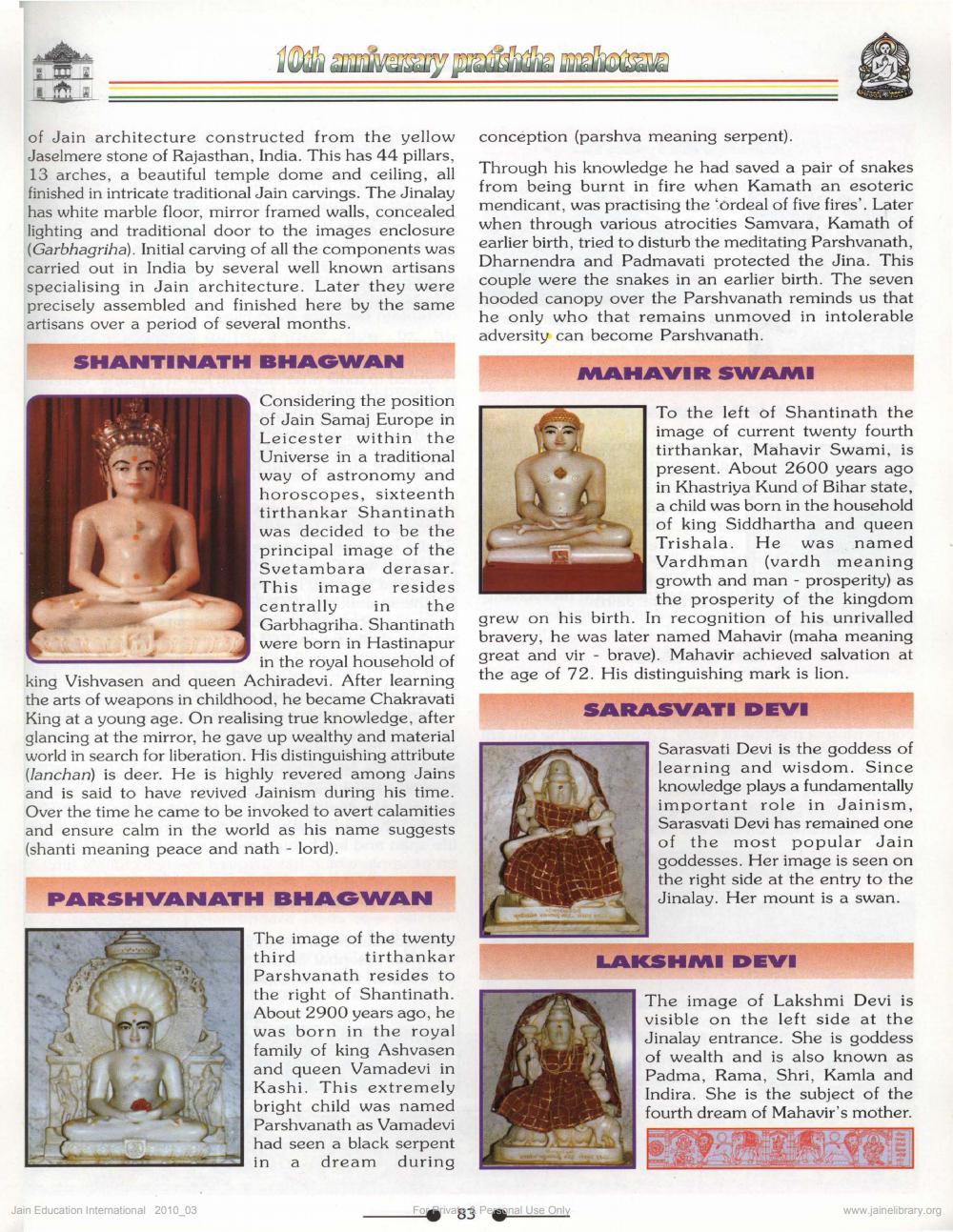________________
10th anniversary pradskéha makotsava
of Jain architecture constructed from the yellow Jaselmere stone of Rajasthan, India. This has 44 pillars, 13 arches, a beautiful temple dome and ceiling, all finished in intricate traditional Jain carvings. The Jinalay has white marble floor, mirror framed walls, concealed lighting and traditional door to the images enclosure (Garbhagriha). Initial carving of all the components was carried out in India by several well known artisans specialising in Jain architecture. Later they were precisely assembled and finished here by the same artisans over a period of several months.
SHANTINATH BHAGWAN
Considering the position of Jain Samaj Europe in Leicester within the Universe in a traditional way of astronomy and horoscopes, sixteenth tirthankar Shantinath was decided to be the principal image of the Svetambara derasar. This image resides centrally in the Garbhagriha. Shantinath Read in SPACE were born in Hastinapur were born in Hastinapur in the royal household of king Vishvasen and queen Achiradevi. After learning the arts of weapons in childhood, he became Chakravati King at a young age. On realising true knowledge, after glancing at the mirror, he gave up wealthy and material world in search for liberation. His distinguishing attribute (lanchan) is deer. He is highly revered among Jains and is said to have revived Jainism during his time. Over the time he came to be invoked to avert calamities and ensure calm in the world as his name suggests (shanti meaning peace and nath - lord).
PARSHVANATH BHAGWAN
The image of the twenty third tirthankar Parshvanath resides to the right of Shantinath. About 2900 years ago, he was born in the royal family of king Ashvasen and queen Vamadevi in Kashi. This extremely bright child was named Parshvanath as Vamadevi had seen a black serpent in a dream during
Jain Education International 2010_03
conception (parshva meaning serpent).
Through his knowledge he had saved a pair of snakes from being burnt in fire when Kamath an esoteric mendicant, was practising the 'ordeal of five fires'. Later when through various atrocities Samvara, Kamath of earlier birth, tried to disturb the meditating Parshvanath, Dharnendra and Padmavati protected the Jina. This couple were the snakes in an earlier birth. The seven hooded canopy over the Parshvanath reminds us that he only who that remains unmoved in intolerable adversity can become Parshvanath.
MAHAVIR SWAMI
To the left of Shantinath the image of current twenty fourth tirthankar, Mahavir Swami, is present. About 2600 years ago in Khastriya Kund of Bihar state, a child was born in the household of king Siddhartha and queen Trishala. He was named Vardhman (vardh meaning growth and man - prosperity) as the prosperity of the kingdom grew on his birth. In recognition of his unrivalled bravery, he was later named Mahavir (maha meaning great and vir - brave). Mahavir achieved salvation at the age of 72. His distinguishing mark is lion.
SARASVATI DEVI
For rivals Personal Use Only
Sarasvati Devi is the goddess of learning and wisdom. Since knowledge plays a fundamentally important role in Jainism, Sarasvati Devi has remained one of the most popular Jain goddesses. Her image is seen on the right side at the entry to the Jinalay. Her mount is a swan.
LAKSHMI DEVI
The image of Lakshmi Devi is visible on the left side at the Jinalay entrance. She is goddess of wealth and is also known as Padma, Rama, Shri, Kamla and Indira. She is the subject of the fourth dream of Mahavir's mother.
www.jainelibrary.org




